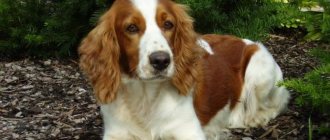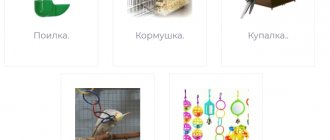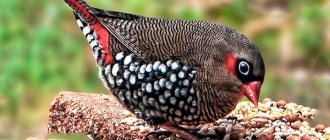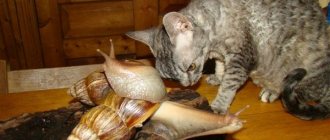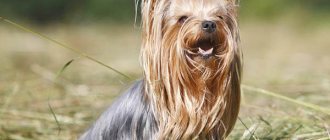Place
It is necessary to equip the puppy with a private place where he can sleep, relax and simply hide from prying eyes. The ideal place for a pet would be a spacious, moderately bright corner in a closed room, where there is not a lot of furniture and small interior items. You should not place the dog near the balcony door, on a cold tiled floor, in a draft, or in places where there is a constant flow of cold air from an air conditioner or fan - this can cause colds. You should also avoid places near radiators and other heating devices - due to constant stay in excessively warm places, the dog becomes susceptible to cold, which reduces the resistance of its body.
Accessories
You need to carefully prepare for the arrival of a new tenant and purchase everything necessary to make your pet comfortable in the new home.
- A lounger where you can comfortably rest and sleep. This could be a small warm rug, a low wooden box with soft bedding, or a basket with low sides.
- Two bowls: for food and water. They can be made of different materials, but they must be wide and low so that the bulldog can eat comfortably.
- A collar with a sign indicating the dog's name and owner's address.
- Leash.
- A muzzle made of soft leather, which is necessary when traveling on public transport, while walking in crowded places or when visiting a veterinary clinic.
- French bulldogs do not tolerate cold well, so for walks in the cold season it is advisable for puppies to purchase clothes (overalls, jacket, hat).
- Active bulldogs need toys so they can play and frolic. Balls, boomerangs, rubber bones should not be small so that the puppy cannot swallow them.
Inventory
In addition to equipping a personal space, proper care of a French bulldog involves purchasing the necessary equipment, the use of which will provide the dog with comfortable and safe living conditions.
Harness or collar?
Harness
Dog handlers and veterinarians advise choosing a harness.
Mainly because of its ergonomics.
Especially when it comes to pets with certain anatomical features.
French bulldogs have a special structure of the respiratory tract, so a harness is the most suitable option for equipment for walking.
It does not pinch the dog's neck and, unlike a collar, does not put strong pressure on its throat in the event of a sharp tug on the leash.
When wearing a collar frequently, gradual injury to the pet's cervical vertebrae occurs, which can cause problems with the spinal cord. In the case of a harness, the load on the dog's shoulders and chest is distributed evenly. In addition, it is easier to control an animal with its help than with a leash and collar.
You should not pull the leash too hard even if your pet is disobedient - this can lead to spinal deformation and back pain.
What is a muzzle for?
Many people believe that French Bulldogs do not need a muzzle because they are friendly and good-natured.
However, even calm and peaceful dogs can experience outbursts of aggression, associated, for example, with the threat of danger to the owner or the dog itself.
Walking your pet in a muzzle, especially in unfamiliar or noisy and crowded places, will help eliminate the likelihood of situations in which he could injure someone or suffer himself.
With a muzzle on, the dog will not be able to pick up and eat anything on the street. In addition, the ability to wear a muzzle will not be superfluous when visiting a veterinarian or in case of long journeys.
Choice
The “Frenchies” have a unique structure of the muzzle and respiratory tract, so when choosing a muzzle it is necessary to take into account many nuances:
- it must be made specifically for this breed;
- seams, fasteners and other elements of the muzzle should not press or rub the pet’s skin;
- The dog should be able to yawn and breathe calmly and evenly with his tongue hanging out.
The muzzle can be solid or mesh and made of leather, metal mesh, plastic or nylon. For “Frenchies,” you should purchase a mesh leather or metal muzzle. The advantages of the first option are soft material and ergonomic shape that takes into account the anatomy of these dogs. But such muzzles are short-lived, require additional care and give the dog the opportunity to reach the garbage with his tongue.
Muzzles made of nickel mesh are designed specifically for dogs with a short muzzle; they are lightweight, fit tightly, do not allow the dog to pick up something from the ground, but provide free breathing and eliminate sweating of the muzzle in the heat. But they should not be worn in rain or cold weather.
Before purchasing a muzzle, you must try it on your dog.
Harness
To make your pet comfortable, you need to buy a harness of the right size, because too big will fall off, and a small one will put pressure. To do this, you need to measure the distance from the withers to the base of the dog’s tail, the circumference of its chest and neck, or try on the harness before purchasing. The harness itself, all straps, fasteners and fastenings must be durable and made of high-quality materials and be adjustable.
Leash length
The length of the leash depends on the purpose of its use: an accessory for walking should be about 1 m, for training - at least 3 m. A leash used for exhibitions should be thin but durable and have loops on both sides.
Choosing the right dog bowl
Due to the structure of the skull, French bulldogs cannot eat or drink from deep bowls.
For representatives of this breed, wide bowls without high sides are suitable, allowing for maneuverability while eating.
As for the material, preference should be given to ceramic or metal heavy dishes that the pet cannot turn over and carry in its mouth. You should also buy a special stand for bowls, the height of which can be adjusted as the dog grows - this will allow him not to bend over while eating or drinking and maintain his posture.
The dishes should be chosen according to the age of the animal - it is inconvenient for a puppy to eat from a large bowl.
Toys and other entertainment
Although outwardly seemingly clumsy and lazy, French bulldogs are distinguished by a high level of activity and love of games.
These dogs love to chase balls and play with various ropes and ropes.
Also popular are all kinds of squeaking toys and rubber or sinew bones that can be chewed.
In addition, the “Frenchies” like joint games of tugging and holding with the owner, but you need to be careful with them - you cannot pull or tear the toy too much from the pet’s mouth, especially during the period of changing teeth, as this can ruin his bite and damage his teeth.
Carrying
Carriers are required if there is a need to transport the dog in a car or public transport. It is important that the crate, container or bag is the right size so that the dog will be comfortable in it. The pet must not only fit into the carrier, but also be able to at least minimally move around it, stand upright, sleep and stretch.
The main thing is that the carrier is ventilated and waterproof - the dog will not be able to stay in it without air, and increased humidity threatens hypothermia, the proliferation of microorganisms and can cause the development of dermatitis and staphylococcus due to diaper rash of the folds. You should not buy soft bags and backpacks - rather large French bulldogs will be uncomfortable in them. It is better to purchase a plastic container, a carrier - a tent or a folding enclosure - they come in different sizes and are easy to wash and disinfect.
Beds
The bed should be chosen in accordance with the size of the pet - it should be able to stretch out to its full height in sleep. If the dog's place is located in a small room, the best option would be a moderately soft bedding, mattress, rug or flat pillow; if we are talking about a large room, you can buy a sofa or house. You should not buy mattresses made of straw or cotton wool - the “Frenchman” can tear them, chew them and eat the contents.
The bed should have removable covers that can be washed.
Dog nutritional features
Any puppy must be immediately accustomed to unknown foods. You can’t follow his lead if he ignores fresh food and immediately change it or improve the taste. The cunning man will quickly realize that his whims are taken into account, and will constantly bargain for a tastier dish.
For eating, one place is allocated, equipped with a pair of low cylindrical bowls: for food and water. Along with the “Frenchman” itself, the volume of the feeding container also grows, in the role of which (at first) old frying pans, pots and cups can be used.
There are several prohibited actions in organizing dog food:
- Do not use glassware (the dog may accidentally break it and get injured);
- do not place a wooden cup (the puppy will try it on his teeth);
- avoid containers with a spherical bottom (they are easy to tip over);
- do not feed from a cup purchased for growing up (the puppy will smear food on the bottom and get used to getting into it with his paws);
- do not teach people to eat from their hands (this is inconvenient for the owner, and the “French” will be spoiled by such serving of food);
- Don't feed your dog wherever you have to (this is a recipe for bad behavior such as stealing and begging).
Important! All bones, except large raw beef bones, more often called sugar bones, are completely excluded. And these are given infrequently, so as not to wear down the teeth.
Don't worry about the apparent monotony of dog food - the main thing is that it is healthy and full of vitamins. The latter, as you know, are more abundant in raw foods. Your task is to maintain a balance in your diet (1/3 should be fiber, 2/3 should be animal proteins (meat, fish, cottage cheese).
Everything that is cooked should not be too liquid/empty, nor too hot or cold (recommended food temperature is +20 +25 degrees).
Return to content
Pet care
Caring for your Frenchie involves bathing and brushing, periodic inspection and cleaning of ears, eyes and teeth, as well as trimming of nails. In addition, it is necessary to promptly vaccinate your pet, treat it against external parasites and regularly deworm it.
Differences in caring for a puppy
There are no fundamental differences in caring for puppies and adult dogs, but it should be remembered that there are some restrictions for puppies. Thus, they cannot be walked or bathed until the end of the quarantine period after vaccinations, and the duration of the first walks should be no more than 15 minutes. It is also necessary to accustom the puppy to a diaper or tray and begin training from the first days of his appearance in the house.
From early childhood, a “Frenchman” must know the boundaries of what is permitted, for which it is necessary to develop rules and regimes and strictly adhere to them. It is important to show the puppy that he is not the boss of the house, otherwise he will take a leadership position and consider himself to be in charge, which will lead to many problems in the future.
Choosing a puppy
It is, of course, best to purchase a puppy from a trusted breeder or a kennel with a good reputation. If you have little understanding of the characteristics of the breed, then invite an independent expert with you. It is important to adhere to the basic rules:
- When buying a puppy, study the photo on the nursery’s website, ask to show the puppy’s parents, at least the bitch, talk to the owner of the nursery, carefully and leisurely study the documents: pedigree, veterinary passport. If the dog has a brand, compare its number with the one indicated on the documents.
- Make sure you have the necessary vaccinations and deworming.
- It is important that the room where the puppies are kept is clean, free of unpleasant odors and dirt.
- If the puppy suddenly didn’t turn up, was sold, got sick, etc., and they started offering you another one, then you shouldn’t cooperate with such an unreliable breeder. He who deceives once will deceive many more times.
- Examine the puppy itself. The puppy must meet the breed standard, be playful, active, cheerful, curious, not cowardly, clean, without unpleasant odors and discharge from the eyes or ears.
Remember that you are purchasing a pet for at least 10 years, and the time or money saved, insufficient research on the issue and a careless approach to choosing a seller can result in a lot of sores, genetic abnormalities or even the quick death of a dog that you and your family will manage to love.
Basic hygiene
Regular implementation of a set of hygiene procedures, which the “Frenchie” must be taught to do from an early age, helps maintain the pet’s beautiful appearance and health.
Nail trimming
Too long nails interfere with the dog's walking.
Because of this, the load on the joints and ligaments is distributed incorrectly and deformation of the paws occurs. If the claws do not grind down on their own during walks, they must be trimmed with a guillotine nail clipper 1-2 times a month so as not to touch the living part. The optimal length of the claws is one at which the dog does not touch the floor with them when walking.
Ear cleaning
“Frenchies” have large and open ears, in which dirt and wax accumulate, which is fraught with inflammation. Your pet's ears should be cleaned twice a month by wiping the inside with a cotton pad soaked in hydrogen peroxide or a special lotion and removing wax from the ear canals with a cotton swab. A dog's tendency to constantly scratch its ears and the appearance of dark discharge and an unpleasant odor from them indicate the presence of a mite, infection or other disease.
Do not push the sticks deep - this can damage the eardrum, which can lead to partial or complete hearing loss.
Eyes
Protruding eyes are a weak point of French Bulldogs. To maintain their cleanliness, you need to wipe them 1-2 times a week with a cotton pad soaked in tea leaves or chamomile infusion. If there is redness, suppuration or increased lacrimation, you should contact your veterinarian.
Teeth
Brush your teeth at least once a week with a special medium-hard brush and a paste or powder intended for dogs - this will help avoid the formation of plaque and tartar.
Care for skin folds
The folds on the face should be regularly wiped with a dry cloth or a cloth soaked in chlorhexidine and lubricated with baby cream. Diaper rash in the folds and the accumulation of dirt or food debris in them contribute to the development of bacteria and inflammation.
Bathing an adult
After each walk, especially in wet weather, you need to wash your dog's paws and belly. You should bathe your pet completely no more than once a quarter using a special shampoo appropriate for the type of coat - more frequent washing can damage its skin and negatively affect the ability of the coat to clean itself.
Bathing during the shedding period helps get rid of excess hair and prevents skin irritation.
Puppy
The puppy can be bathed only after he has received all the necessary vaccinations and the quarantine is over. When washing, you need to place a rubber mat on the bottom of the bathtub or sink to prevent your baby's paws from slipping and make sure that water does not get into his ears.
What do French bulldogs suffer from?
Funny dogs of this breed are prone to certain diseases. Although this does not mean that your pet will have all of the listed health problems. But if any of them occur, it is better to consult a veterinarian.
Diseases that French Bulldogs are susceptible to include:
- Allergies. The most common are allergic reactions to food, such as poultry, beef, and others. Also, the animal’s body can react to household chemicals, cosmetics and other external factors. As a result, skin inflammation occurs (contact dermatitis).
- Brachycephalic syndrome is associated with a structural feature of the dog’s muzzle and manifests itself in the form of breathing problems and other associated symptoms.
- Eye problems - conjunctivitis, prolapse (prolapse) of the lacrimal gland of the third eyelid, as well as mechanical injuries.
- Problems with the spine - the formation of “wedge-shaped vertebrae,” which usually occurs in adulthood, vertebral hernias, and more.
Carefully monitor the dog’s condition, his behavior and even his mood. Any changes could be a sign of potential health problems.
Help the pet

